Intel Core i9-13900K and i5-13600K Review: Raptor Lake Brings More Bite
by Gavin Bonshor on October 20, 2022 9:00 AM ESTClosing Thoughts
When Intel officially announced Raptor Lake back at Intel Innovation 2022, it coincidentally fell on the same day that AMD's latest Ryzen 7000 processors were made available in retail stores. Although it did take a little bit of sting out of AMD's launch, that's something that's become par for the course in what's become a highly competitive consumer CPU market. Now Intel's 13th Generation Core processors are here, and following AMD's well-received Zen 4 launch, the biggest question to be answered today is "how has Intel responded?"
Getting straight to the point when it comes to analyzing the Raptor Lake platform and Intel’s new Raptor Cove performance (P) cores, there’s no escaping the fact that it feels like Alder Lake 2.0. Which isn't a bad thing given how competitive Alder Lake was when directly compared against AMD’s Ryzen 5000 series, both in regards to performance and price. Intel had a strong platform with Alder Lake, one that the company believes is strong enough to keep up with AMD's latest with the addition of a few performance tweaks.
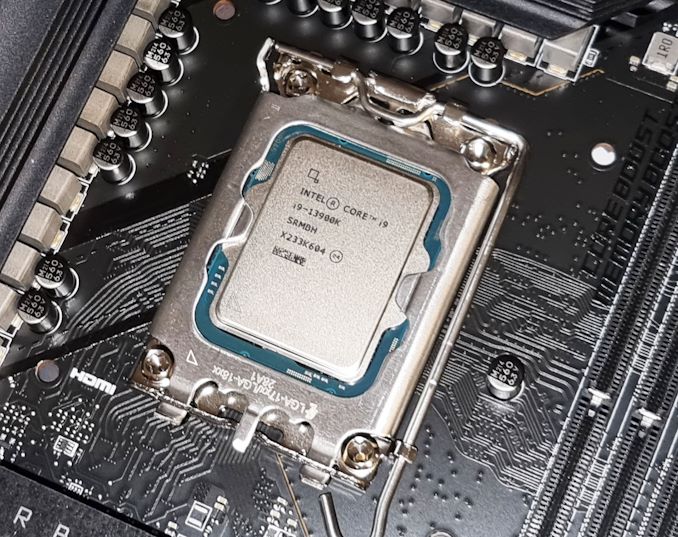
Intel Core i9-13900K installed into an MSI MPG Z790 Carbon WIFI motherboard (LGA 1700)
The biggest improvement over Alder Lake comes through an improved and more optimized voltage frequency (V/F) curve, where Intel has squeezed out an extra 200 MHz at iso-voltage, or a reduction of 50 mV at iso-frequency. These benefits are clear to see, especially with the very high turbo core frequency of up to 5.8 GHz on the Core i9-13900K. It’s worth mentioning that this is actually 5.7 GHz when temperatures rise above 70°C, as per Intel’s Thermal Velocity Boost (TVB) technology, or when the power limits allow it; so these highest clockspeeds are attained mostly in single-threaded applications rather than multi-threaded.
Of course, the fact that Intel has now doubled the number of efficiency (E) cores compared to Alder Lake should not go unmentioned. This means the Core i9-13900K now has a total of 24 CPU cores (8P+16E), making for a total of 32 threads. Meanwhile the Core i5-13600K has 14 cores, with 6P+8E, up from 10-cores (6+4E) on the previous Core i5-12600K. With more efficiency cores, the levels of performance in multi-threaded applications have also gone up, but not without increasing the PL1/PL2 limits to 253 W. As a result, Raptor Lake draws more power than its predecessor, but performance levels have also risen generationally speaking.
Also contributing to Intel's gains here are a few cache and other memory improvements. Both the P and E-cores have larger L2 caches for better hit rates, and the L3 cache size has been scaled up to accommodate the larger number of E-cores, bringing the top-end 13900K to 36MB of L3. All of the Raptor Lake chips are also validated for faster DDR5 memory support, allowing them to run at DDR5-5600(B) before any memory overclocking. While not as significant as merely adding more cores or higher clockspeeds, these changes help Intel squeeze out a bit more performance from what is essentially an evolved Alder Lake design.
Intel 13th Gen Core: Moving Ahead, Highly Performance Competitive with Zen 4
Looking at how the performance of Intel's latest 13th Gen Core series processors compares to AMD’s Ryzen 7000 series, there are certain aspects to like about both efforts. The two lineups can be very competitive, depending on the type of workload undertaken; some benchmarks we’ve tested favor the Zen 4 core, and others put the highly clocked Raptor Cove P-cores ahead. And others still favor Intel’s adding more cores overall, even if they're only efficiency cores.

A little less than a month ago we saw AMD’s Ryzen 9 7950X hit 38K in Cinebench R23’s multi-threaded test, Intel has now gone one better. The Core i9-13900K has broken the 40K mark, and we're seeing pretty good rendering performance from the Core i5-13600K, too. The Core i5-13600K throughout the majority of our testing puts it close to the level of the Ryzen 9 5950X and the Core i7-12700K, which makes for a good value given its $319 MSRP.
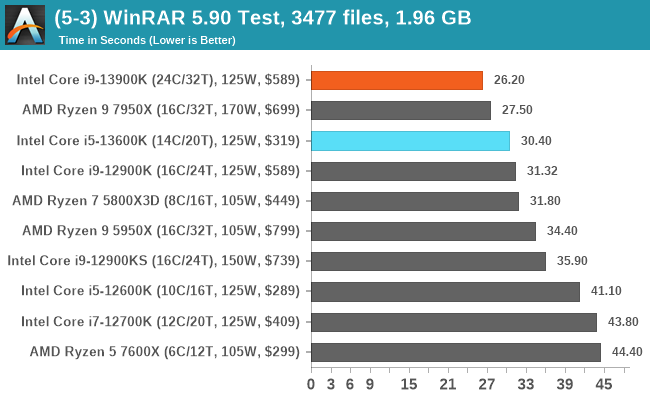
In the bulk of our testing, things really came down to what workload is favored by which core architecture. We saw extremely potent simulation performance from the Core i9-13900K, while the Ryzen 9 7950X does exceptionally well in encoding. Making judgments on performance across the multiple areas of compute, the CPU performance lead is a consistent battle across our entire benchmark suite.
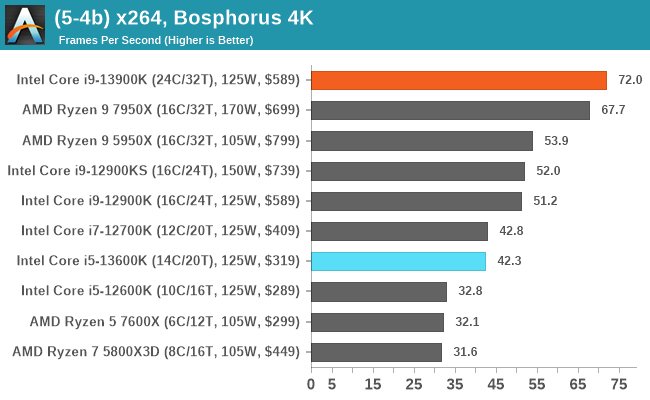
This is how close overall performance is, and the crux of it is, Raptor Lake is a revamped core, and Zen 4 is on a new process node (5 nm). Either way, Intel looks very good here, especially in terms of pricing.
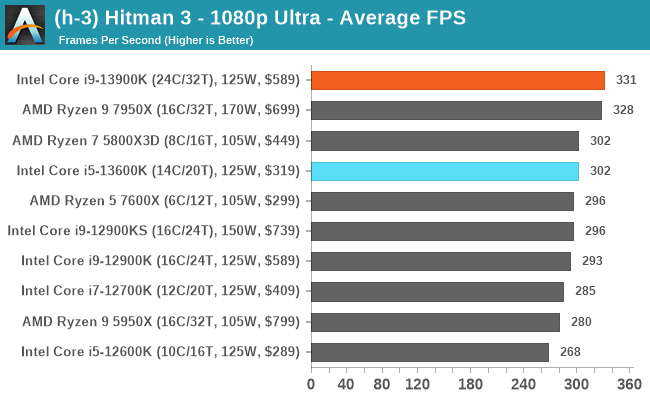
When it comes to gaming performance, both AMD and Intel boldly claim that their latest processors provide solid improvements in frame rates. Against previous generations such as the Ryzen 5000 series and Intel’s 12th Gen Core series, Intel has been able to deliver on those claims; though both AMD and Intel still fall to the unique Ryzen 7 5800X3D and its 96 MB of 3D V-Cache from time to time.
Trying to decide who has the edge when it comes to gaming really comes down to what title it is, what resolution you’re gaming at, and what money you want to spend. Theoretically, even the Core i5-13600K at $319 is very competitive against the more expensive flagship offerings. In fact, despite how good the Core i9-13900K and the Ryzen 9 7950X are in terms of powerful compute performance, the unsung hero when trying to find a bit of value in the current global financial climate could easily be Core i5-13600K.
Raptor Lake and Zen 4 Flagships Trade Blows: But Where's the Value?
Most of the talking points are understandably going to be focused on Intel and AMD’s latest flagship processors, and quite rightly so, as these are the chips pushing the envelope in terms of CPU performance. In the case of the Core i9-13900K, the improvements that Intel has delivered on via higher clockspeeds, more cache, and more E-cores delivers a tangible (and in some cases, significant) performance improvement. As a result Raptor Lake is on a level performance footing with the powerful Ryzen 7000 series.
But Intel is doing this at a much more competitive price point; not just at face value with chip MSRPs, but on additional costs such as cheaper motherboards than what's available for the brand-new AM5 platform. It's a similar story for memory support, as Raptor Lake (still) features support for both DDR5 and DDR4 memory, while AMD’s limited Ryzen 7000 support to DDR5 only. Granted, you will lose performance going with slower memory, but for the price-conscientious, the option is at least there.
As many have voiced concerns about it on social media, Reddit, and online communities, trying to find that value factor in Zen 4 has is a difficult task. Yes, Zen 4 has more affordable processors, but factor in a brand new AM5 motherboard and some DDR5 memory, and the total price tag can quickly add up.
Touching on platforms, Intel’s existing Z690 platform offers support for 13th Gen Core series processors, and as Intel has claimed, there shouldn't be any CPU performance differences between the new Z790 and the current Z690 chipset. The only real differences coming through I/O, with more PCIe 4.0 lanes available from the Z790 chipset (x8), at the cost of the same amount of PCIe 3.0 lanes. This allows motherboard vendors to add more exotic controllers such as Thunderbolt 4 or leverage more M.2 slots.
So where’s the value? Well, the value looks to be in the Core i5-13600K, which if you consider that the 13th Gen Core i5 is now a 12-core part, offers up some stiff competition to the previous generation Core i7-12700K and in some cases, the Core i9-12900K. Add that to the fact you can pair this with a cheaper Z690 or B660 motherboard and go with DDR4 memory, and that extra budget saved can go to another area such as graphics or storage.
If however if raw horsepower-driven performance is exactly what you’re after for tasks such as rendering, video editing, and encoding, then the Core i9-13900K certainly does tick the right boxes. First of all, it trades blows with the more expensive AMD Ryzen 9 7950X, so technically both brands share the crown now depending on the workload undertaken. Secondly, elaborating on the first point, the Core i9-13900K ($589) is around $100 cheaper than the Zen 4 flagship, which sweetens the deal somewhat.
You will likely, however, end up paying back at least some of the difference over time in regards to power consumption. While Intel has put together a very competitive chip, they've also put together a chip that will guzzle power when allowed to – even more so than 12900K(S). In our testing, power consumption topped out at a absurd 335 Watts, over 100W more than the Ryzen 9 7950X. Those high frequencies and the additional E-cores don't come for free, even with Intel's v/f curve improvements reducing the cost.
The wildcard factor here is that what 13900K can draw and what it's allowed to draw are not always the same thing. As has been the case for a few generations now, motherboard vendors have been more than happy to remove (or at least greatly increase) the PL2 limits on high-end Intel boards by default, all in the name of eking out every last bit of performance. And that gap between PL2 and the natural limits of a chip has never been wider for Intel. Raptor Lake brings a lot of bite, but it also bites back.
A motherboard that actually follows Intel's rules and caps PL2 at 253 Watts would net a significant power reduction, but the performance results would suffer as well – likely by just a couple of percent, given how far up the v/f curve the 13900K is. Meanwhile all of this sits in notable contrast to the AM5 platform, which, at least in our launch testing, did not exceed AMD's equivalent metric, PPT, which is 230W. So as measured out of the box, AMD has a very obvious energy efficiency advantage in the desktop market right now.
Ultimately, as we test the defaults for a chip/platform as much as possible, the 335W peak figure is accurate for what self-builders are going to see out of the box if they assemble a high-end 13900K system. OEM systems and self-builds using more modest motherboards, on the other hand, are far more likely to respect PL2, reducing power consumption and performance in the process.
Given the rise in energy costs this year (especially in Europe), this probably isn't great timing for a 335W consumer CPU. Still, it is what it is, for better or worse. But the silver lining is that all that configurability that lets PCs overclock can also be used in reverse to cap power consumption. So as part of our follow-up testing will be playing with power for both AMD and Intel's latest chips, to see where performance lies when various power limits are in place.
Final Thoughts: Competition is Healthy, and Necessary
Power aside, AMD and Intel are both in very competitive position right now. Despite coming at the problem of PC performance with two vastly different architectures (who had Intel leading the core count wars on their 2022 bingo card?), the two have arrived at very similar places with regards to CPU performance. Sometimes they tie and sometimes they do not, but both vendors largely trade blows in equal amounts. To put it another way, the Core i9-13900K (and Raptor Lake as a whole) rises to the level competition, but it doesn't consistently beat it.
As is usually the case in these situations, there is no single, undisputed winner. Generalists will want to weigh things like power consumption and platform costs, as well as ancillary features like PCIe 5.0 storage. Meanwhile any buyers with a handful of specific workloads in mind will be best served by evaluating those workloads first to see whether either chip is superior for their needs.
In the end, it's likely that Intel adopters and fans will favor Intel, and the same can be said about the Zen Army. But in between both sides is an important nugget of truth: AMD and Intel are very close in performance right now. This is a scenario promotes healthy competition, and one which will help drive future innovations and improvements. So it will be interesting to see what happens in 2023 as we see the remaining product stacks, as well as the eventual mobile counterparts.


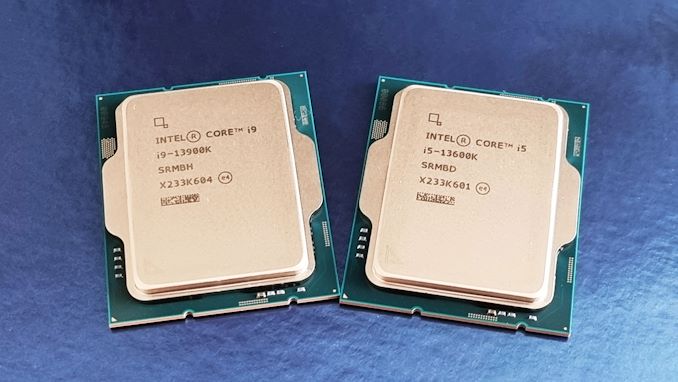
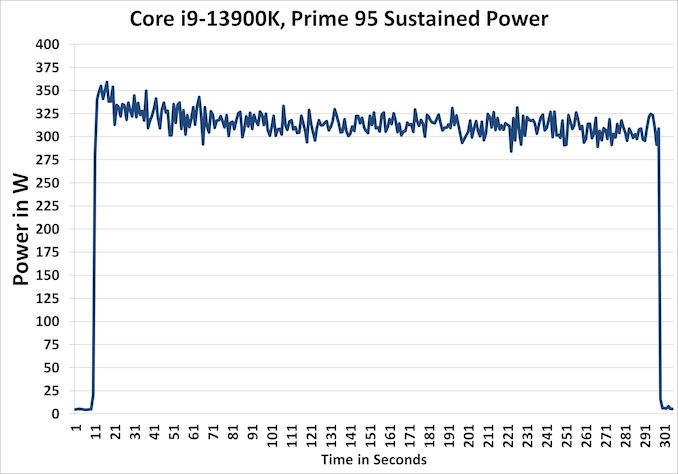








169 Comments
View All Comments
OreoCookie - Tuesday, October 25, 2022 - link
Yes, TDP has a meaning, and technically, neither company is using it correctly. Back in the good-ol’ days when TDP was really max power under load, it easily allowed you to spec a cooler. Clock boosts were meant to be temporary, transient states so that *on average*, you’d still lie within the thermal budget of the cooler. Obviously, we are well past that.So yes, AMD is playing it a bit loose (+31 %). But Intel is playing it ridiculous: the i9’s max power (as tested here) is 2.7x (!) their “TDP”. Reply
shaolin95 - Thursday, October 20, 2022 - link
AMD does the same thing. dont be a fanboy Replyyh125d - Thursday, October 20, 2022 - link
If you're equating AMD going ~50w over TDP to intel going 210w over TDP, you're being the fanboy. ReplyYojimbo - Friday, October 21, 2022 - link
AMD's turbo clocking is more than 50W. ReplyYojimbo - Friday, October 21, 2022 - link
i checked and it's 60 W. That doesn't make AMD "less dishonest”. Neither company are being dishonest. It means AMD does not intend their desktop products to be used in lower power products. If you want to design a product around a Ryzen 7950X you need a 170 W cooling solution. Whereas you can put an i9 13900K in a product that can only dissipate 125 W. That's the difference between the two processors in terms if the TDPs. That's what TDP means. ReplyTruebilly - Friday, October 21, 2022 - link
I'd like to see someone run that 13900k with 120mm rad ReplyWrs - Friday, October 21, 2022 - link
I mean, it works. The processor automatically steps down the v/f curve and doesn't hiccup with a puny cooler good for 140'ish W. I tested a 12900k with a low-profile AXP-200 from my Skylake days. Performance wasn't bad, over 4GHz all 16 cores. I left all the OC settings on, or else stock E-cores would be 3.9GHz. Replynandnandnand - Thursday, October 20, 2022 - link
Go look at some efficiency curves for the 7950X and 13900K, for example at 19:00 in Hardware Unboxed's review: https://www.youtube.com/watch?v=P40gp_DJk5E ReplyYojimbo - Friday, October 21, 2022 - link
none of the companies "do” anything here. The "doing" is by the people who, though they are ignorant, write seething rants in comment sections damning the companies. Replybji - Friday, October 21, 2022 - link
This issue would be a lot less contentious if technical sites like Anandtech actually used their expertise to curate information presented. They just shouldn't even show TDP as it's simply not relevant to the end users who are reading the articles. They should have some standard benchmark they run to determine peak and maximum sustained power draws and show ONLY those values in any charts. Reply